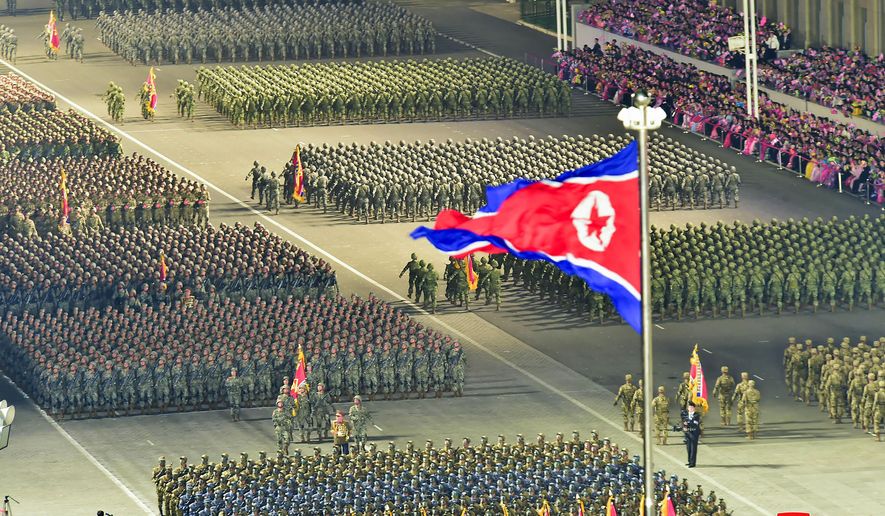North Korean dictator Kim Jong-un vowed to ramp up his country’s nuclear forces in the “fastest possible” way in a feisty speech at a major nighttime military parade where several banned intercontinental ballistic missiles were on display.
Monday night’s parade in Pyongyang marked the 90th anniversary of the founding of North Korea’s armed forces — the Korean People’s Revolutionary Army — and was attended by thousands of ceremoniously-organized soldiers and spectators.
South Korea’s Yonhap News Agency reported that the North’s Hwasong-17 intercontinental ballistic missile (ICBM) was among an arsenal displayed during the parade, noting that the Kim regime claims to have recently tested a Hwasong-17, which North Korean state media calls a “monster missile.”
In his speech, Mr. Kim stressed that Pyongyang is committed to making thorough preparations for using nuclear deterrence anytime, according to Yonhap, which cited reports from the Korean Central News Agency, the North’s main propaganda outlet.
“The fundamental mission of our nuclear forces is to deter a war, but our nukes can never be confined to the single mission of war deterrent even at a time when a situation we are not desirous of at all is created on this land,” Mr. Kim was quoted as saying.
He also warned that any force seeking military confrontation will perish, saying the North is “now fully prepared for any type of war,” Yonhap reported.
Regional analysts say the North is likely to test a nuclear weapon before the end of the year, with some having predicted that Pyongyang could have carried out such a test to mark Monday’s anniversary.
A nuclear test by Pyongyang would shake up the regional and global security landscape while South Korea is preparing to swear in a hawkish president and the U.S. and its top allies are consumed with the fallout from Russia’s invasion of Ukraine.
Analysts say Pyongyang is increasingly eager to put pressure on President Biden after more than a year of watching his administration’s foreign policy moves.
North Korea last tested a nuclear device in 2017, creating an underground explosion with a yield in excess of 100 kilotons TNT equivalent, a dramatic increase from the less than 25 kiloton yield of previous tests in 2013 and 2016.
North Korea watchers have been on edge since mid-March when reports emerged that satellite imagery had picked up signs of construction at the Punggye-ri nuclear testing facility for the first time since the Kim regime claimed to have shuttered the site in 2018.
The regime carried out all six of its nuclear tests from 2006 to 2017 in underground tunnels beneath a mountain at Punggye-ri.
SEE ALSO: North Korea nuclear test may be imminent as Kim amps up pressure
• Guy Taylor can be reached at gtaylor@washingtontimes.com.




Please read our comment policy before commenting.